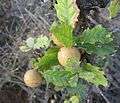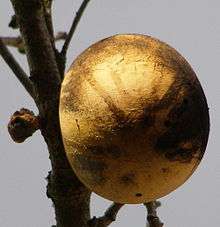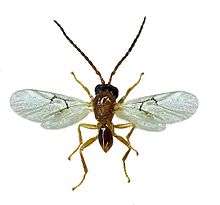Oak apple

Oak apple or oak gall is the common name for a large, round, vaguely apple-like gall commonly found on many species of oak. Oak apples range in size from 3⁄4 to 2 inches (2 to 5 cm) in diameter and are caused by chemicals injected by the larva of certain kinds of gall wasp in the family Cynipidae.[1] The adult female wasp lays single eggs in developing leaf buds. The wasp larvae feed on the gall tissue resulting from their secretions. Considerable confusion exists in the general "literature" between the oak apple and the oak marble gall. The oak marble is frequently called the oak apple due to the superficial resemblance and the preponderance of the oak marble gall in the wild. Other galls found on oak trees include the oak artichoke gall and the acorn cup gall, but each of these has its own distinctive form.
Some common oak-apple-forming species are the Biorhiza pallida gall wasp in Europe, Amphibolips confluenta in eastern North America,[2] and Atrusca bella in western North America.[1] Oak apples may be brownish, yellowish, greenish, pinkish, or reddish.
Iron gall ink
Oak galls have been used in the production of ink since at least the time of the Roman Empire. From the Middle Ages to the early twentieth century, iron gall ink was the main medium used for writing in the Western world.[3]
Folklore
It is said that if a "worm" is found inside the gall on Michaelmas Day, then the year will be pleasant and unexceptional, and if a spider is found, then it will be a bad year with shortages and ruined crops. If a fly is found inside, then it will be a moderate season, and if nothing is found, then serious diseases will occur all that year.[4]
Oak Apple Day (or Royal Oak Day) is a former public holiday in England on 29 May that commemorated the Restoration of Charles II in 1660. The popular name refers to the event during the English Civil War when Charles hid in an oak tree. The commemoration persists in some areas today, although festivities have little to do with the Restoration.
Gallery
 An oak apple on an oak leaf.
An oak apple on an oak leaf.- An oak tree with multiple oak apples.
 Andricus kollari oak gall
Andricus kollari oak gall Oak apples on an oak tree.
Oak apples on an oak tree. Oak apple gall on Garry oak (Quercus garryana), Sonoma County, California
Oak apple gall on Garry oak (Quercus garryana), Sonoma County, California- Oak apples on oak leaf and in cross section, Willamette Valley, Oregon.
 Biorhiza pallida male
Biorhiza pallida male
See also
References
- 1 2 Cranshaw, Whitney (2004). Garden Insects of North America. Princeton, New Jersey: Princeton University Press. ISBN 0-691-09560-4.
- ↑ Oxford English Dictionary
- ↑ Diringer, David (1 March 1982). The Book Before Printing: Ancient, Medieval and Oriental. Dover Publications. pp. 551–2.
- ↑ Roud, Steven (2003). The Penguin Guide to the Superstitions of Britain and Ireland. Pengun Books. p. 344.
External links
| Wikimedia Commons has media related to Galls on Quercus. |
- Amphibolips confluenta
- Biorhiza pallida
- Gloucestershire Naturalists' Society photograph of galls with 'red apple' appearance See also:
- The Oak Apple Gall